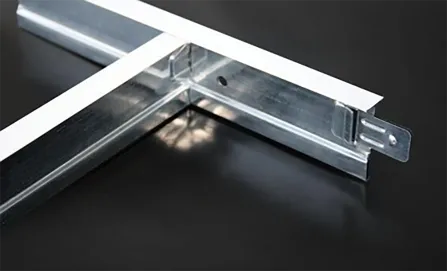- Afrikaans
- Albanian
- Amharic
- Arabic
- Armenian
- Azerbaijani
- Basque
- Belarusian
- Bengali
- Bosnian
- Bulgarian
- Catalan
- Cebuano
- Corsican
- Croatian
- Czech
- Danish
- Dutch
- English
- Esperanto
- Estonian
- French
- German
- Greek
- Hindi
- Indonesian
- irish
- Italian
- Japanese
- Korean
- Lao
- Malay
- Myanmar
- Norwegian
- Norwegian
- Polish
- Portuguese
- Romanian
- Russian
- Serbian
- Spanish
- Swedish
- Thai
- Turkish
- Ukrainian
- Uzbek
- Vietnamese
nov. . 05, 2024 04:23 Back to list
mineral fiber ceiling board specification
Understanding Mineral Fiber Ceiling Board Specification
When it comes to modern construction and interior design, ceiling materials play a significant role in aesthetics, functionality, and building performance. Among various options available, mineral fiber ceiling boards have emerged as a popular choice due to their excellent acoustic properties, fire resistance, and ease of installation. This article aims to provide a detailed understanding of the specifications and benefits of mineral fiber ceiling boards, helping architects, contractors, and homeowners make informed decisions.
What is Mineral Fiber Ceiling Board?
Mineral fiber ceiling boards are ceiling tiles or panels made primarily from mineral-based materials, including fiberglass, such as cellulose or other natural materials. These boards are manufactured using a process that combines these fibers with binders and additives, resulting in durable and lightweight panels. They are widely used in both residential and commercial applications because of their versatility and functional characteristics.
Key Specifications
1. Acoustic Performance One of the primary reasons for using mineral fiber ceiling boards is their outstanding acoustic performance. These boards are designed to absorb sound, reducing noise levels in a room. The Noise Reduction Coefficient (NRC) is a critical specification that indicates how effective a material is at absorbing sound. Mineral fiber ceiling boards typically have an NRC rating of 0.70 to 0.90, making them suitable for environments such as offices, schools, and healthcare facilities where noise control is essential.
2. Fire Resistance Safety is a vital factor in construction materials. Mineral fiber boards are inherently non-combustible and have a high fire-resistance rating, usually classified as Class A according to ASTM E84 standards. This property ensures that in the event of a fire, these boards will not contribute to the spread of flames or smoke, making them a safe choice for high-rise buildings and public spaces.
3. Moisture Resistance High humidity environments can adversely affect many types of ceiling boards. Mineral fiber ceiling boards are designed to resist moisture and mold growth. Some products, particularly those coated with a special treatment, can be classified as humidity-resistant, making them an excellent choice for areas such as kitchens and bathrooms.
mineral fiber ceiling board specification

4. Thermal Insulation Mineral fiber ceiling boards provide added thermal insulation, contributing to energy efficiency in a building. By reducing heat loss during winters and minimizing heat gain during summers, these boards can help maintain comfortable indoor temperatures while potentially lowering energy bills.
5. Design and Aesthetics Mineral fiber ceiling boards come in various styles, textures, and finishes, allowing designers to achieve the desired aesthetic while maintaining functionality. They can be painted, textured, or even printed, offering a wide range of design flexibility suitable for various architectural styles.
6. Sustainability Many manufacturers produce mineral fiber ceiling boards using recycled materials, making them an environmentally friendly option. Additionally, their longevity and durability contribute to sustainable building practices, as they require less frequent replacement compared to other ceiling materials.
Installation and Maintenance
The installation of mineral fiber ceiling boards is relatively straightforward. They can be suspended from a grid system, allowing easy access for maintenance and repairs. This modularity is particularly beneficial in commercial settings where serviceability is essential. Additionally, cleaning and maintenance are minimal; periodic dusting or wiping with a damp cloth is typically sufficient to maintain their appearance.
Conclusion
In summary, mineral fiber ceiling boards are an exceptional choice for various applications due to their excellent acoustic performance, fire resistance, moisture durability, and aesthetic versatility. Their specifications make them suitable for environments that demand high safety standards and design flexibility. As more builders and designers seek sustainable building materials, the use of mineral fiber ceilings is likely to grow, contributing to healthier and more functional indoor environments. By understanding these specifications, stakeholders can leverage the benefits of mineral fiber ceiling boards in their projects, enhancing both comfort and safety for occupants.
-
Transform Interiors with PVC Gypsum Ceiling: A Stylish, Durable, and Moisture-Resistant SolutionNewsMay.19,2025
-
The Smart Interior Upgrade: Discover the Durability and Versatility of Gypsum Ceiling Access Panel SolutionsNewsMay.19,2025
-
The Smart Choice for Interior Design: Discover the Value of PVC Gypsum Ceiling SolutionsNewsMay.19,2025
-
Mineral Fiber Ceiling Tiles: The Smart Blend of Performance and AestheticsNewsMay.19,2025
-
Mineral Fiber Ceiling Tiles: The Superior Choice Over Gypsum for Sound and Fire SafetyNewsMay.19,2025
-
Mineral Fiber Ceiling Tiles: Eco-Friendly Strength and Style for Every CeilingNewsMay.19,2025







